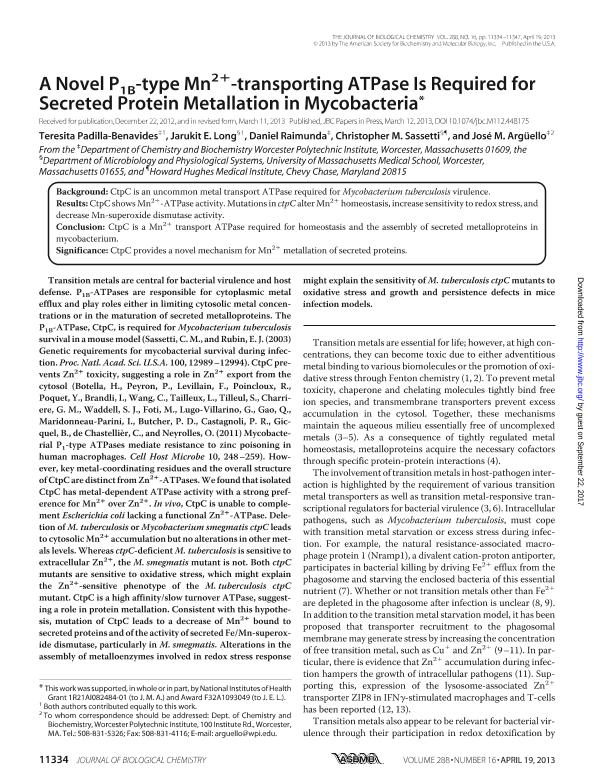Mostrar el registro sencillo del ítem
dc.contributor.author
Padilla Benavides, Teresita
dc.contributor.author
Long, Jarukit E.
dc.contributor.author
Raimunda, Daniel Cesar

dc.contributor.author
Sassetti, Christopher M.
dc.contributor.author
Argüello, José M.
dc.date.available
2017-09-22T17:46:10Z
dc.date.issued
2013-03
dc.identifier.citation
Padilla Benavides, Teresita; Long, Jarukit E.; Raimunda, Daniel Cesar; Sassetti, Christopher M.; Argüello, José M.; A Novel P1B-type Mn2+-transporting ATPase is required for secreted protein Metallation in mycobacteria; American Society for Biochemistry and Molecular Biology; Journal of Biological Chemistry (online); 288; 3-2013; 11334-11347
dc.identifier.issn
0021-9258
dc.identifier.uri
http://hdl.handle.net/11336/24940
dc.description.abstract
Transition metals are central for bacterial virulence and host defense. P1B-ATPases are responsible for cytoplasmic metal efflux, and play roles either in limiting cytosolic metal concentrations or in the maturation of secreted metalloproteins. The P1B-ATPase, CtpC, is required for Mycobacterium tuberculosis survival in a mouse model (Sassetti and Rubin (2003) Proc. Nat. Acad. Sci. 100, 12989-12994). CtpC prevents Zn2+ toxicity, suggesting a role in Zn2+ export from the cytosol (Botella, et al., (2011) Cell Host Microbe 10, 248-259). However, key metal coordinating residues and overall structure of CtpC are distinct from Zn2+-ATPases. We found that isolated CtpC has metal dependent ATPase activity with a strong preference for Mn2+ over Zn2+ . In vivo, CtpC is unable to complement Escherichia coli lacking a functional Zn2+-ATPase. Deletion of M. tuberculosis or M. smegmatis ctpC leads to cytosolic Mn2+ accumulation but no alterations in other metals levels. While ctpC-deficient M. tuberculosis is sensitive to extracellular Zn2+ , the M. smegmatis mutant is not. Both ctpC mutants are sensitive to oxidative stress, which might explain the Zn2+-sensitive phenotype of the M. tuberculosis ctpC mutant. CtpC is a high affinity/slow turnover ATPase, suggesting a role in protein metallation. Consistent with this hypothesis, mutation of CtpC leads to a decrease of Mn2+-bound to secreted proteins and of the activity of secreted Fe/Mnsuperoxide dismutase, particularly in M. smegmatis. Alterations in the assembly of metalloenzymes involved in redox stress response might explain the sensitivity of M. tuberculosis ctpC mutants to oxidative stress, grow and persistence defects in mice infection models.
dc.format
application/pdf
dc.language.iso
eng
dc.publisher
American Society for Biochemistry and Molecular Biology

dc.rights
info:eu-repo/semantics/openAccess
dc.rights.uri
https://creativecommons.org/licenses/by-nc-sa/2.5/ar/
dc.subject
Ctpc
dc.subject
Mn2+-Atpase
dc.subject
Soda
dc.subject
Mycobacterium Tuberculosis
dc.subject.classification
Bioquímica y Biología Molecular

dc.subject.classification
Ciencias Biológicas

dc.subject.classification
CIENCIAS NATURALES Y EXACTAS

dc.title
A Novel P1B-type Mn2+-transporting ATPase is required for secreted protein Metallation in mycobacteria
dc.type
info:eu-repo/semantics/article
dc.type
info:ar-repo/semantics/artículo
dc.type
info:eu-repo/semantics/publishedVersion
dc.date.updated
2017-09-21T19:04:31Z
dc.journal.volume
288
dc.journal.pagination
11334-11347
dc.journal.pais
Estados Unidos

dc.description.fil
Fil: Padilla Benavides, Teresita. Worcester Polytechnic Institute; Estados Unidos
dc.description.fil
Fil: Long, Jarukit E.. University Of Massachussets. Medical School; Estados Unidos
dc.description.fil
Fil: Raimunda, Daniel Cesar. Worcester Polytechnic Institute; Estados Unidos. Consejo Nacional de Investigaciones Científicas y Técnicas; Argentina
dc.description.fil
Fil: Sassetti, Christopher M.. University Of Massachussets. Medical School; Estados Unidos. Howard Hughes Medical Institute; Estados Unidos
dc.description.fil
Fil: Argüello, José M.. Worcester Polytechnic Institute; Estados Unidos
dc.journal.title
Journal of Biological Chemistry (online)

dc.relation.alternativeid
info:eu-repo/semantics/altIdentifier/url/http://www.jbc.org/content/288/16/11334
dc.relation.alternativeid
info:eu-repo/semantics/altIdentifier/doi/http://dx.doi.org/10.1074/jbc.M112.448175
dc.relation.alternativeid
info:eu-repo/semantics/altIdentifier/url/https://www.ncbi.nlm.nih.gov/pmc/articles/PMC3630897/
Archivos asociados
